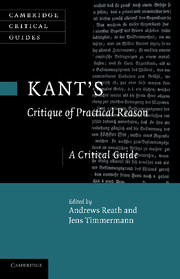Book contents
- Frontmatter
- Contents
- Preface
- List of contributors
- Translations and abbreviations
- Introduction
- 1 The origin and aim of Kant's Critique of Practical Reason
- 2 Formal principles and the form of a law
- 3 Moral consciousness and the ‘fact of reason’
- 4 Reversal or retreat? Kant's deductions of freedom and morality
- 5 The Triebfeder of pure practical reason
- 6 Two conceptions of compatibilism in the Critical Elucidation
- 7 The Antinomy of Practical Reason: reason, the unconditioned and the highest good
- 8 The primacy of practical reason and the idea of a practical postulate
- 9 The meaning of the Critique of Practical Reason for moral beings: the Doctrine of Method of Pure Practical Reason
- Bibliography
- Index
7 - The Antinomy of Practical Reason: reason, the unconditioned and the highest good
Published online by Cambridge University Press: 06 August 2010
- Frontmatter
- Contents
- Preface
- List of contributors
- Translations and abbreviations
- Introduction
- 1 The origin and aim of Kant's Critique of Practical Reason
- 2 Formal principles and the form of a law
- 3 Moral consciousness and the ‘fact of reason’
- 4 Reversal or retreat? Kant's deductions of freedom and morality
- 5 The Triebfeder of pure practical reason
- 6 Two conceptions of compatibilism in the Critical Elucidation
- 7 The Antinomy of Practical Reason: reason, the unconditioned and the highest good
- 8 The primacy of practical reason and the idea of a practical postulate
- 9 The meaning of the Critique of Practical Reason for moral beings: the Doctrine of Method of Pure Practical Reason
- Bibliography
- Index
Summary
The Antinomy of Practical Reason has received far less attention than most other sections in the Critique of Practical Reason, despite the fact that few are seriously tempted to reject its fundamental systematic and philosophical importance within Kant's practical philosophy. This comparative neglect is both unfortunate and remediable. It is unfortunate because focusing on it makes clear the conception of practical reason that Kant uses and needs to use within his practical philosophy as a whole. It is remediable because its basic features can be determined without excessive difficulty if one pays attention to the significant parallels it displays with the Critique of Pure Reason's Antinomy of Pure Reason.
In a first section, I briefly present the basic structure of the Antinomy of Pure Reason, paying special attention to the role that reason plays in generating this antinomy. In the second section, I reconstruct the Antinomy of Practical Reason with the help of several basic structural similarities that it bears to the theoretical antinomy. In a third section, I turn to several basic questions that arise with respect to the Antinomy of Practical Reason's central concept of the highest good, and use insights gained from the comparison of the theoretical and practical antinomies to develop detailed answers.
THE ANTINOMY OF PURE (THEORETICAL) REASON
In the Antinomy of Pure Reason of the Critique of Pure Reason, Kant claims that if one accepts what he calls Transcendental Realism – the view that appearances and things in themselves are identical – then reason can come into conflict with itself, because it can prove contradictory propositions with respect to certain features of the world.
Keywords
- Type
- Chapter
- Information
- Kant's 'Critique of Practical Reason'A Critical Guide, pp. 145 - 167Publisher: Cambridge University PressPrint publication year: 2010
- 7
- Cited by



